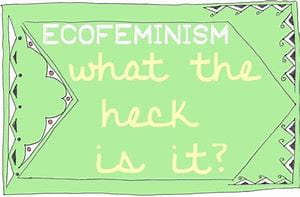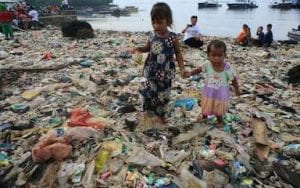ECOFEMINISM. WHAT IS IT?
This blog gives a bird’s eye view of this political and or philosophical global feminist movement that highlights the control of nature, woman, and animal by the patriarchy. This knowledge is the foundation of its work. Recognition of this calls for a collaborative society where there is no gender dominance, in order to address environmental concerns, and find sustainable solutions. As unifying a movement as this appears, racism reared its ugly head, leaving Afro-Ecowomanists feeling undermined.
In ecofeminist principles, author Hobgood-Oster wrote “life on earth is an interconnected web, not a hierarchy,” and western industrial civilization subjugated women. In “Historic International Evolution,” Hobgood-Oster posits, that racism within ecofeminist, and feminist dialogues has been prominent. “White ecofeminist,” she contends, “have often essentialized racial difference.” (10) Essentialism assumes that cross-culturally and historically people of a particular race and gender share the same traits. (13) One would assume that mind set is archaic, so too the racism faced by African-American Ecowomanist in this feminist movement. Theirs is an intersection of race and gender, but racism is most dominant. Hobgood-Oster reminds us “the political power of white women in academic organizations undermines women of color.” (10) “They identify with racism as the most dominant oppression in their experience, while sexism is secondary.” (11) “Environmental racism,” Hobgood-Oster adds, is growing in the USA and globally, thus resulting in shifting political alliances of ecowomanists, from a feminist agenda to one engaging in issues of race and class. (11) Shamara Riley in “Ecofeminism and The Sacred” agrees. “…Afrocentric ecowomanism … articulates link between male supremacy and environmental degradation, there is far more stress on distinctive features such as race and class that leave an impression markedly different from ecofeminists’ theories” (197) (11)
“The term” writes Hobgood-Oster “was introduced by Francoise d”Eaubonne in her book La Feminisme ou la Mort (Feminism or death 1974.) There is no acceptable or orthodox “ecofeminism,” (1) it is multifaceted and multi-located. This is echoed by Warren in “Introduction to Ecofeminism” who states there are different perspectives such as liberal, racial socialist, third world, and black which reflect different feminist perspectives and different understandings of the solution to pressing environmental problems. Hobgood-Oster reminds us that oppression in its varied forms are connected and emerged from the patriarchal systems, with the domination of woman, nature, and animals. Ecofeminism challenges this system through various political alliances from different angles. This system justifies its dominance-per ecofeminism, by dualistic hierarchies-like mind/body, male/female, heaven/earth, white/non-white. The patriarchy continues their abuse by “reinforcing assumptions based of these binaries,” (3) for example into religious constructs. In the Bible’s book of Genesis, Eve the woman was demonized, and the animal-the snake.
Ecofeminists have engaged in protests, and boycotts to bring attention to injustice related to women and the environment; they also engaged in antinuclear and antimilitarists protests during the height of the cold war. (9) They try to stay connected globally. They met at the U.N. conference in Nairobi in 1985 and connected with local artists to continue their work against oppression of women. Likewise, in Chile, organized by Con-Spirando Collective which operates a woman center in Santiago focusing on ecofeminist activism and tries “to weave a network of women in Latin America interested in feminist theology and ecofeminism and women holding rituals.” (12) There is the connection with animals and the focus on the meat industry with the exploitation of women. As unified as this movement appears, the scourge of racism is present. The white women in these organizations are powerful politically and often undermine women of color. (10) Perhaps not surprisingly, there are critics of the movement, ecofeminists themselves who question the woman and nature link, the core of ecofeminism. (12) There are many literary works on this topic-such as (a) Lerner, Gerda. “The Creation of Patriarchy.” (b) Plumwood, Val. “Feminism and the Mastery of Nature.” (c) Shamara Shantu, Riley. “Ecofeminism and the Sacred” One is reminded of the expectation of the movement. “Things will not just happen … women must do something.” (Gaard, ed., 3) Spoken by Wangari Maathai (renowned Kenyan social activist-and first African woman to win the Nobel Prize, and NAACP image Award, not mentioned in the readings) at the world women’s congress for a Healthy Planet in 1991.
Is feminism relevant today? According to Purnima Singh if only for environmental discourse. The movement’s spread started in Chipko India in the early 1970, the Green Belt (started By Maathai) in Kenya later in that decade, and antinuclear pro-environment movements in the west in the 1980s and 1990. Singh contends that environment damage is a feminist issue, along with climate change-both urgent social global issues today. For it to be intersectional she argues, focus must be on relationships women have in society with each other. She cites indigenous women who live close to nature and suffer a lot in the face of environmental degradation. Such communities need to be empowered and supported, to avoid further degradation. There is a paucity of recent answers to this questions on line.
- Identify one of Warren’s connections.
The one I chose is #3. Empirical and Experiential connections.
Plastic in the cross hairs. The U.N. environmental forum states that environmental damage is behind !:4 global deaths. Caption next to the photo.
The photo echoes Warren’s linking children, people of color with environmental destruction. One could assume in that sea of plastic, there are pollutants. Warren argues that “First World Development polices result in practices regarding food and water which contributes to women’s inabilities to provide for their families.” The explosion of plastic especially in drink is global. I have encountered travellers who bemoan this as they visit villages in various countries with residents most of whom are poor. But the little marts in the areas are full of these drinks- most of which are unhealthy, and expensive, but sought for because they are foreign and convey a sense of importance with the ability to purchase. These eventually litter their environment because of a lack of refuse disposal. These mega drinks producing First World Companies, do not provide or assist local governments in those villages in refuse disposal.
One traveller expressed sorrow at seeing in an Asian country a young girl who should be in school, picking up plastic for a mart owner for a nominal fee. We both felt that it is likely she could be a victim of rape.
In the Ecofeminism Background reading, the author states that “ecofeminists argue that we must look at our relationship with the environment through a feminist perspective.” We are warned by them that “environmental degradation is brought about by male -centered thinking(androcentric), and we must look to our patriarchal culture for the roots of domination of nature, woman, ideals and values associated with “maleness” If this is the expectation for feminist who are mostly women, it begs the question, why is there essentialist thinking, perhaps the cover for the practice of racism in the movement? Or perhaps the underpinnings of the start of the feminist movement, which did not include non-white women. Where do we go from here? Can white women achieve these goals alone? They are accused of speaking for women. With a paucity of information on the movement’s relevance today, a more inclusive approach might salvage the work accomplished years ago and energize younger women.
Source. Singh, Purnima. ‘Is Ecofeminism Relevant Today.’ Oct. 29 2019 in Intersetional Feminism- Desi-Style!




I agree the use of plastic is outrageous, although here in America we recycle it still isn’t enough, we should just be able to reuse. However, large cooperations make their money off of convenience and I do believe that it will not stop any time soon. Other smaller and less fortunate areas around the globe get their water straight from the source there isn’t any convenience, it is just what we have become a custom to. I myself have been trying to alleviate as much disposable use of products as possible, even if it is recyclable. I related to your reading on organic feminine products, I switched from regular tampons to organic tampons a few years ago and at some point last year I did invest in a diva cup. However the use of it is now as easy as one may think. I do agree that the menstrual cups are a fantastic idea, but I do think there needs to be more knowledge and awareness put out about the effectiveness in helping the earth and also how to use it to it’s full potential.
Great responses! I like how you brought up Afro-Eco womanists and how they put more of an emphasis on racism than sexism. I think that is an important subject to touch on, because ecofeminism is much larger than just feminism. In actuality, we are talking about oppression, which we see everywhere, played out in many different scenarios. It is wild to think that there is oppression even within the movement itself. By focusing on oppression other than sexism, it helps break ecofeminism out of whatever box someone may put it in just by hearing the work “feminism” in it. So often are feminists silenced because someone doesn’t want to hear about the usual talking points that they associate with feminism. Afro-Eco womanists take it in a whole new direction however by focusing primarily on race whilst still being part of the eco-feminism which obviously incorporates sexism and environmental degradation. Understanding of the Afro-Eco womanist viewpoint helps me appreciate eco-feminism more because I know that it. I think that the change will come about first when we realize just how prolific it is.